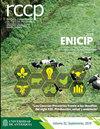轻度限饲后饲喂高营养日粮对肉鸡生产性能的改善
IF 0.5
4区 农林科学
Q4 AGRICULTURE, DAIRY & ANIMAL SCIENCE
引用次数: 2
摘要
背景:在肉鸡中使用早期营养限制计划可以预防并发症,如体脂沉积增加及其后果。然而,饲料限制并不总是能得到预期的结果。目的:评价2个水平的限饲后5个水平的再营养期对肉仔鸡生长性能和免疫应答的影响。方法:实验动物330只。各处理分别为:发育期定量限饲25% (T25)和35% (T35),生长期和育肥期分别提高0、2.5、5、7.5、10和15%的能量和蛋白质含量。结果:除T25-0外,各T25处理肥育期采食量(FI)和增重(BWG)较高,饲料系数(FCR)较低(p0.05)。结论:在轻度限饲一段时间后饲喂营养密度高的饲粮可获得最佳效果,而与标准饲粮相比,在更严格的限饲后增加营养密度并不能提高生产效果。饲粮限制水平和营养密度对胴体性状和免疫功能均无影响。本文章由计算机程序翻译,如有差异,请以英文原文为准。
Improvement in broiler performance by feeding a nutrient-dense diet after a mild feed restriction
Background: The use of early nutrient-restriction programs in broilers can prevent complications such as increased body fat deposition and its consequences. However, feed restriction not always gives the expected results. Objective: To assess the effect of two levels of feed restriction followed by a re-alimentation period with five increasing nutrient levels on growth performance and immune response of broiler chickens. Methods: A total of 330 animals were used. The treatments were: 25 (T25) and 35% (T35) quantitative feed restriction during the starting period, and 0, 2.5, 5, 7.5, 10, and 15% increased energy and protein contents during the growing and finishing periods. Results: For all the T25 treatments, except for T25-0, feed intake (FI) and body weight gain (BWG) were higher, and feed conversion rate (FCR) was lower (p<0.05) compared to the control treatment. In that group, the response of FI and BWG to the increased nutrient density was mostly quadratic (p<0.001), whereas that of FCR was linear (p<0.001). The FI and BWG results were less homogeneous in the T35 treatments, but FCR was lower compared to the control treatment (p<0.05) in all of them. The FCR showed no differences (p>0.05) between treatments during the finishing period. Conclusion: Feeding a nutrient-dense diet after a period of mild feed restriction gives the best results, while increasing nutrient density after a more severe feed restriction does not improve productive results compared to a standard diet. Carcass traits and immune function were not affected by restriction level or nutrient density.
求助全文
通过发布文献求助,成功后即可免费获取论文全文。
去求助
来源期刊

Revista Colombiana De Ciencias Pecuarias
AGRICULTURE, DAIRY & ANIMAL SCIENCE-
CiteScore
0.80
自引率
0.00%
发文量
18
审稿时长
6-12 weeks
期刊介绍:
The editors of Revista Colombiana de Ciencias Pecuarias (RCCP) welcome the submission of original manuscripts on experimental and clinical studies associated with the broad areas of animal sciences and veterinary medicine as they interface with biochemistry, molecular biology, physiology, pharmacology, toxicology, pathology, microbiology, parasitology, immunology and epidemiology. The scope of the journal includes studies of basic and applied research in animal management and production, feeding and nutrition, reproduction, breeding, genetics, animal welfare and behavior; as well as animal production focussed from biotechnology, soil science, agrostology, silvopastoral systems, livestock economics and the environment.
The criteria for acceptance of papers submitted for publication are originality, quality and clarity of the content. Each contribution must be based on original, unpublished research that has not been simultaneously submitted to other journals. All papers will be peer reviewed. All authors bear responsibility for ensuring the integrity and quality of their reported research. It is the author''s responsibility to secure permission to use figures or tables that have been published elsewhere.
Contributions may be classified as original research, review, rapid communication, clinical case studies or methodological articles, as well as news/commentaries or letters to the editor. Most review articles are invited by the editor. Authors interested in submitting a review article should contact the corresponding editor. Rapid publication of original manuscripts is a goal of the journal. Manuscripts must be written in English. Each manuscript is considered for publication with the understanding that it has not been simultaneously submitted to any other journal. Upon acceptance for publication, papers are subject to editorial review and revision.
 求助内容:
求助内容: 应助结果提醒方式:
应助结果提醒方式:


